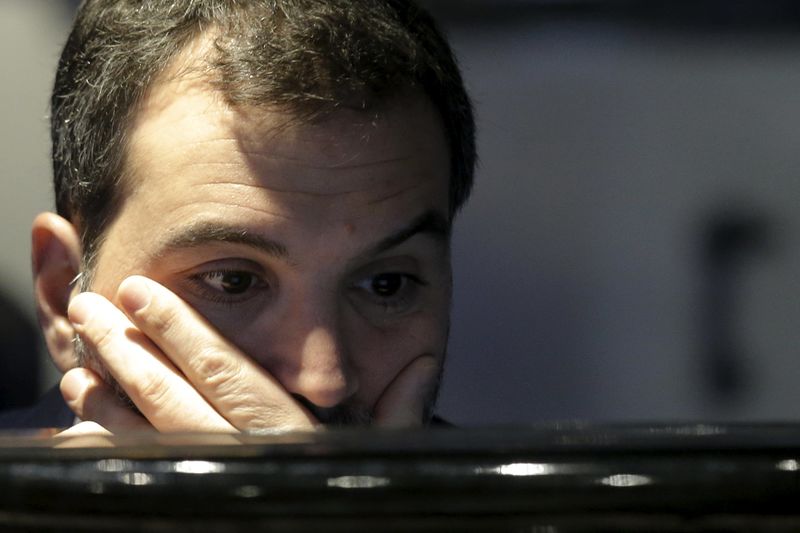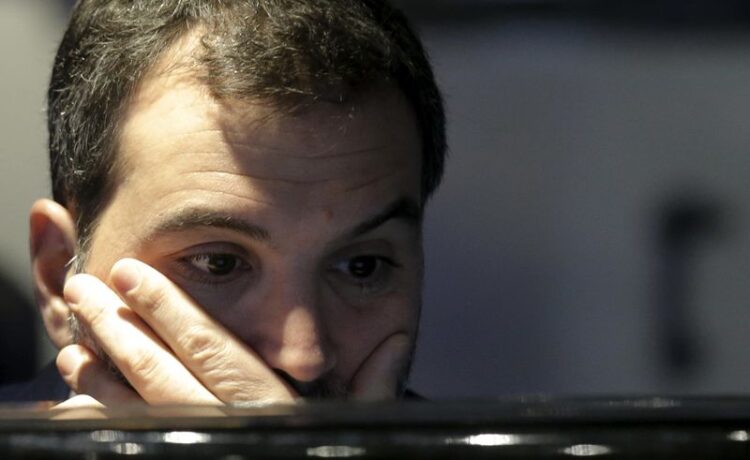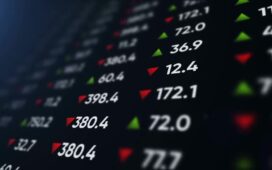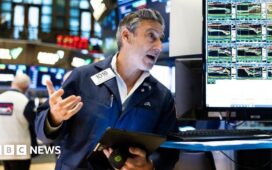
© Reuters.
HASI has reported a record-breaking performance for the fourth quarter and full year of 2023, with significant increases in distributable earnings and net investment income. The company’s portfolio saw a substantial growth, and a dividend increase was declared. Guidance for the upcoming years indicates continued growth and a focus on achieving both financial and climate goals. The company’s earnings call highlighted its successful investment strategy, strong liquidity, and confidence in the energy transition sector.
Key Takeaways
- Record $2.3B in new investments closed at yields over 9%, growing the portfolio by 44%.
- Distributable earnings up 7% to $2.23 and net investment income increased by 21%.
- Quarterly dividend raised to $0.415, reflecting an $0.08 annualized increase.
- Guidance projects 8-10% compound annual growth in earnings over the next three years.
- Anticipated reduction in payout ratio to reach a long-term goal of 50%.
- Portfolio yield at 7.9% versus interest expense of 5.0%.
- Over $930M in liquidity available, with $1.9B of debt raised in the past year.
- Near-term investment opportunities expected to yield 11%.
- Strong demand in energy and fuel sectors, with a focus on adding new clients and expanding into new sectors.
- Stable risk profile maintained despite higher market yields.
Company Outlook
- HASI expects to maintain profitable growth and healthy margins throughout 2023.
- Guidance includes future dividend increases with a targeted payout ratio of 60% to 70% from 2024 to 2026.
Bearish Highlights
- Portfolio cash inflows slightly down year-over-year due to lower cash from equity method affiliates and poor wind performance.
Bullish Highlights
- Company remains confident in its business model and long-term success in the energy transition.
- Liquidity remains robust, which supports the company’s growth strategy and investment opportunities.
Misses
- Poor wind performance in 2023 resulted in delayed distributions, but this is expected to improve and is accounted for in guidance.
Q&A Highlights
- Marc Pangburn discussed total portfolio collections and consistent cash yield.
- Jeffrey Lipson provided clarity on the payout ratio and emphasized the consistency of risk appetite and underwriting standards.
- In response to a question about the impact of higher rates on risk appetite, the company reiterated its stable risk profile and the availability of higher-yielding investments without changing risk parameters.
InvestingPro Insights
In light of HASI’s strong performance and strategic confidence, recent data from InvestingPro provides additional context for investors considering the company’s stock. With a market capitalization of $2.87 B and a high earnings multiple, HASI is trading at a P/E ratio of 64.52, which adjusts to 74.37 when looking at the last twelve months as of Q3 2023. Despite this high multiple, which suggests a premium valuation, the company’s commitment to shareholder returns is evident, as indicated by a significant dividend yield of 6.19% and a history of raising its dividend for 5 consecutive years.
An important InvestingPro Tip to consider is that HASI has maintained dividend payments for 11 consecutive years, showcasing a strong track record of returning value to shareholders. Moreover, analysts remain optimistic about the company’s profitability, predicting net income growth this year. This aligns with the company’s guidance for continued earnings growth and a focus on financial and climate goals.
Investors looking to delve deeper into HASI’s financial health and future prospects can find additional InvestingPro Tips by visiting https://www.investing.com/pro/HASI. There are 9 InvestingPro Tips in total, offering insights such as the company’s liquidity position, with liquid assets exceeding short-term obligations, and expectations for profitability in the current year.
To explore these insights and more, investors can use the coupon code PRONEWS24 to get an additional 10% off a yearly or biyearly Pro and Pro+ subscription at InvestingPro. This is an opportunity to access a wealth of financial analysis and data to inform investment decisions.
Full transcript – Hnn Armstrng Stn (HASI) Q4 2023:
Operator: Greetings, and welcome to HASI’s Fourth Quarter and Full Year 2023 Earnings Conference Call and Webcast. At this time, all participants are in a listen-only mode. A brief question-and-answer session will follow the formal presentation. [Operator Instructions] As a reminder, this conference is being recorded. It is now my pleasure to introduce your host, Neha Gaddam, Senior Director, Investor Relations and Corporate Finance.
Neha Gaddam: Thank you, operator. Good afternoon, everyone, and welcome. Earlier this afternoon HASI distributed a press release detailing our fourth quarter and full year 2023 results, a copy of which is available on our website. This conference call is being webcast live on Investor Relations’ page of the website, where a replay will be available later today. Some of the comments made in this call are forward-looking statements, which are subject to risks and uncertainties described in the risk factors section of the company’s Form 10-K and other filings with the SEC. Actual results may differ materially from those stated. Today’s discussions also include some non-GAAP financial measures. A reconciliation of GAAP to non-GAAP financial measures is available on our posted earnings release and slide presentation. Joining me on today’s call are Jeff Lipson, the company’s President and CEO; Marc Pangburn, CFO; and Susan Nickey, our Chief Client Officer. Susan will be available for the Q&A portion of our presentation. Now, I’d like to turn the call over to Jeff, who will begin on Slide 3. Jeff?
Jeffrey Lipson: Thank you, Neha and good afternoon, everyone. Thank you for joining the call. 2023 was a record year for HASI, producing outstanding results as our non-cyclical and adaptable business model overcame the challenges presented by disruptive capital markets. We increased our distributable earnings by 7% to $2.23 and increased our net investment income by 21%. We were able to close a record volume of $2.3 billion of new investments at a yield greater than 9%. This volume facilitated a 44% increase in our portfolio, which creates a foundation for continued revenue growth. We also declared a dividend of $0.415 for the quarter, an increase of $0.08 on annualized basis from the prior quarter. Our ability to achieve these results in spite of the 2023 operating backdrop, including volatile interest rates, provides us ongoing confidence that our long term business model driven by our climate, clients, asset strategy is exceedingly resilient and the path forward to achieving our financial and climate goals. Turning to Slide 4. As a reminder, our long term business model is to continue to produce 10% EPS growth, consistent with our first 10 years as a public company. And we have also previously indicated that over the long term, we are targeting a payout ratio of 50%, retaining the remaining 50% of our earnings to re-invest, while shifting to less reliance on equity issuance. Today, we are pleased to announce earnings and dividend guidance over the next three years consistent with our long term business model. Our earnings guidance reflects reacceleration to 8% to 10% compound annual growth through 2026 using a 2023 base year. The midpoint is above our 2023 growth rate, but very slightly below our long term business model due to this period, including significant refinancing activity. However, this difference between the guidance and the business model should be viewed as a positive data point, as even in more difficult operating environments, the impact on earnings growth is minimal. Our dividend guidance reflects our continued gradual reduction in the payout ratio as we increase our dividend, but at a slower rate than our earnings. We typically paid 100% of our earnings as dividends prior to 2018, gradually reducing the ratio to 71% in 2023, and we expect this gradual reduction to continue to occur during the guidance period with a payout ratio between 60% and 70% as we continue to make progress towards our 50% goal. However, just as the actual dividend per share increased between 2018 and 2023 while the payout ratio was decreasing, investors should expect our dividends to continue to grow during the guidance period. We would expect to achieve our long term target of a 50% payout ratio later this decade, after which earnings and dividends are expected to have identical growth rates. While we believe our base case model that drives guidance is a balanced view of upside opportunities and downside risks, there are scenarios that would result in earnings above our guidance, including a second investment grade rating, which would presumably reduce our debt costs or expansion of our investment platform, resulting in higher transaction volumes or improved return on underlying investments. Each of these items would have a positive impact on our margin. In summary, this guidance reflects an enthusiastic and confident vision of our company and strategy over the next three years. And we remain optimistic that we have the talent, client relationships and market opportunity that will result in continued growth and prosperity. Turning to Page 5. I’d like to reinforce that for many years we have consistently accomplished our disclosed objectives. On our Investor Day in March of 2023, we discussed several strategic priorities and in each case kept our promise. We executed on a seamless CEO and CFO transition, invested at higher yields without incremental risk, expanded our fuels, transport and nature segment, continued to access diversified sources of debt, were placed on positive outlook by Fitch, discontinued our REIT election and migrated the business to be less reliant on capital markets via capital-led initiatives and dividend policy. It is also worth noting that we expect to achieve our prior earnings guidance in 2024 and we are meeting our dividend guidance with today’s announcement. We have an unblemished track record of meeting or exceeding our guidance. Achieving our disclosed objectives reflects both the predictability of our lower risk business model and the reliability of our messaging. Turning to Page 6. I’d like to address four items that represent our most frequent investor questions. Beginning with policy. We are attentive of public policy and engage in advocacy efforts. However, we do not fundamentally believe that public policy will have a meaningful impact on our business over the guidance period. Our company has been successful in administrations from either party and thrived prior to the IRA. In addition, clean energy demand continues to grow exponentially, including at the state and corporate level, and the levelized cost of energy supports further development. Our company is also well positioned to pivot to a variety of investment alternatives, which further provides comfort that public policy changes are not likely to be impactful to our profitability. Regarding interest rate risk, we have prudently navigated this period of interest volatility, which began in 2022. Since that time, we have not wavered in our execution, implementing a strategy of pricing our investments to produce our targeted margins. These higher yielding investments do not include higher risk, but rather reflect broad industry adaptation to higher rates. We’ve also deployed a hedging program which has allowed us to navigate the high rate environment successfully and minimized the risk of rates moving further upward. Next, we are often asked about project delays. However, the risk of potential short term delays in certain asset classes is mitigated by the diversity of our investment strategy, as evidenced by our 2023 investment volumes and our current pipeline. And long term economic fundamentals will allow our clients to maintain active pipelines. Finally, our ability to fund record volumes in 2023 is proof positive that our liquidity and funding strategy is sound. Our risk to capital markets volatility has largely been muted for 2024, as we have already pre-financed much of our pipeline with recent debt transactions. If markets are attractive, we will consider early refinancing of upcoming maturities, but are otherwise in a strong position related to funding needs over the next 12 months. In summary, and as reflected by our new guidance, we believe the business remains well positioned to address any perceived headwinds. And with that, I’d like to turn the call over to Mark.
Marc Pangburn: Thank you, Jeff. I’ll start on Slide 7. Underpinning the guidance, Jeff discussed is our pipeline of over $5 billion, which is highly diversified across three markets, eight asset classes, over 30 programmatic clients and over 150 unique transactions, a portion of which represent greater than $25 billion of project CapEx from our 10 largest clients. We continue to be excited about growth in all three markets and the growing number of new clients that we can serve. Our pipeline has grown significantly from $3 billion in 2020 to greater than $5 billion in 2024, a reflection of our success and organizational structure that supports programmatic transactions. A unique element of our business is our ability to pivot between asset classes, seeking the most attractive risk adjusted returns and adapting to market conditions. Our annual closings since 2020 confirm the power of a diverse asset strategy as our volumes are consistent while our growth in the underlying end markets are not. We continue to see a vastly expanded opportunity set in front of us, driven by the underlying demand in all of our markets for energy transition assets and services. Moving on to Slide 8. For a full year 2023, we are reporting distributable EPS of $2.23. We closed a record volume of new transactions at $2.3 billion. Year-over-year, our volumes increased 28%, distributable NII increased 21% and gain on sale increased 15%. Notably, our portfolio grew 44% providing a much larger base for long term recurring income. And looking to the top right, this portfolio growth is at higher yields with incremental on balance sheet investments yielding greater than 9%, a material shift up relative to prior years. Continuing to the next slide, we have a track record of stable growth along all notable metrics. Since 2019, we have grown our distributable EPS by a 12% CAGR, distributable NII by a 28% CAGR, and gain on sale by a 23% CAGR. The total managed assets has almost doubled to $12.3 billion highlighting the increasing scale in the business. One key ratio reflecting the benefit of scale is the growth in our key performance metrics relative to SG&A. Year-over-year, combined NII and gain on sale increased by 19%, while SG&A only increased by 2%. While we are happy with this result directionally, we believe there are more benefits to gain as we scale. On Slide 10, our portfolio yield increased to 7.9% while the portfolio grew by $1.9 billion. This growth compares to the previous three year annual average of $700 million. In the fourth quarter, we funded $609 million of new and previously closed investments and anticipate funding additional commitments of $500 million through 2024. Additionally, with the growth in FTN and community solar, our portfolio has attained a higher level of diversification in 2023. On Slide 11, our focus on profitable growth has contributed to maintaining healthy margins throughout 2023, with a portfolio yield of 7.9% compared to interest expense of 5.0%. In ’23, we made incremental investments at an average yield greater than 9% with new cost of debt 7%, and we expect that over time we will benefit from improved cost of funds if a second investment grade rating can be attained. To provide another data point, in our recent corporate debt offering materials, we identified a near term investment opportunities, which are anticipated to yield 11%. This results in ROEs of mid to high-teens relative to where the offerings priced. Looking along the bottom of the slide. In the past quarters, we’ve provided additional context to address questions on our ’25 and ’26 bond refinancings. As a reminder, the base rate for the expected bond refinancings are currently hedged around 3%. Based on market spreads, a theoretical refinancing would result in a blended cost of debt of 5.6%, resulting in a 12.5% ROE. Turning to Slide 12. Our funding platform was critical to our success in 2023. Starting on the top left with over $930 million, our liquidity remains robust. The total liquidity includes approximately $300 million of corporate unsecured debt and non-recourse secured debt, both of which closed in January. Our current leverage is 2 times debt to equity and 92% is either fixed or hedged. Over the past 12 months, we’ve raised $1.9 billion of debt, a vast majority of which was used to fund portfolio growth. Importantly, we utilized all sources of debt available to us, highlighting our diverse funding platform. The recent high yield offering, secured debt raise and existing liquidity substantially address our growth debt capital needs for 2024. We will consider opportunistic windows for refinancing or extending our ’25 debt maturities throughout the course of this year. While liquidity or balance sheet funding remains strong, we continue to progress our capital light initiatives to further diversify our funding platform. In summary, our execution to date, current liquidity and go forward plans, position us extremely well to capitalize on the opportunity ahead. I’ll now turn the call back to Jeff.
Jeffrey Lipson: Thanks, Mark. Turning to Slide 13. We summarized a few of our sustainability and impact highlights from 2023, including our alignment with the EU taxonomy and other items related to advocacy, disclosure and philanthropic priorities, as well as summarizing the impact of our investments as measured by our carbon count metric. We’ll conclude on Slide 14. As I reflect on my first year as CEO of HASI, I am extremely proud of our many accomplishments in 2023 and I remain confident that our three year business planning process has concluded that all of the components of long term success are in place. As I said on Investor Day back in March, HASI is the preeminent climate pure play with a differentiated strategy that allows investors to access the growth trajectory of the energy transition in a low risk business model. This strategy of focusing on climate positive asset level investing with the leading sponsors and developers continues to be successful and provide ongoing shareholder value. Our business model has proven resilient despite many headwinds, and our new guidance reflects a path forward to consistent profitability and less reliance on capital markets. I thank our dedicated team for their outstanding achievements in 2023 and their enthusiasm and commitment to our future success. Thank you for joining the call. And I’ll ask the operator to open the line for questions.
Operator: Thank you. We will now be conducting a question-and-answer session. [Operator Instructions] And our first question is from Brian Lee with Goldman Sachs. Please proceed with your question.
Brian Lee: Hey. Good afternoon, everyone. Thanks for taking the questions. Maybe just starting off with the longer term, three year earnings growth outlook. Can you kind of give us a sense, I don’t know, if you think about it in that context, but you mentioned how your portfolio yields have moved higher. You gave us an indication of kind of what cost capital is today. Sort of, what are you baking into your sort of medium to longer term, maybe tail end of that forecast in terms of where you think yields kind of settle out? And then, where also you think cost of capital and then, obviously spreads could ultimately sort of settle in that forecast horizon?
Jeffrey Lipson: So, thanks for the question, Brian. I would say in our base case, we primarily use the forward curve rather than making any of our own predictions related to rates. And from a credit spread perspective, we’re using credit spreads on both the investment side and the debt side, fairly similar to where they are today, and projecting that forward. With obviously some range on that as we build out the guidance. And that’s in part why guidance has some range to it. But I would say as our general baseline, those are the numbers we’re using for rates and credit spreads.
Brian Lee: Okay. Fair enough. I guess, my question was more around, it sounds like there’s some opportunistic assets, and I know there’s been some segment make shifts, namely more FTN versus historical. Is there opportunity in that three year horizon to kind of drive portfolio yields higher and hence earn kind of a higher return spread from that vantage point? I guess, that was sort of the angle I was taking with that question, just giving mix shift and potential for, I guess, refinancing at the same time?
Jeffrey Lipson: Sure. And I think I did. And I’ll just reiterate what I said in my prepared remarks. I think, I did say, there’s upside to guidance and it’s mostly around debt costs could be lower than we forecasted, especially, if we get that second investment grade rating. Volumes could be higher, particularly, if we go into some new markets that are not necessarily into our base plan, but that we’re thinking about. And then, the third one I identified was that the return on the individual investment level could be higher than we forecasted, which I think is the one that’s responsive to your question. So, yes, there is an opportunity for yields over the next three years to be a bit wider than we forecasted, and that would be an upside to our guidance.
Brian Lee: Okay. Fair enough. And then maybe one more question for me, and I’ll pass it along. There’s been a lot made in the press about some of the challenges in the residential solar segment in the U.S. and I know you have some unexpected exposure there. Can you remind us kind of — as you head into ’24 where that mix lies in your portfolio? What you’re embedding in kind of the near term view as to additional growth there? And then, with some of these publicized bankruptcies and developers having some challenges in the marketplace, how are you sort of navigating that credit risk? What’s embedded in kind of your portfolio exposure if you will? Thank you.
Jeffrey Lipson: Sure. And maybe what I’ll do, Brian is, I’ll start out and Marc and Susan may add to my answer as well. But I would say as a baseline, first of all, that our resi solar portfolio itself is performing very well and we are at the asset level and the homeowners continue to make payments on their leases. And we are very comfortable with our exposure and it is performing. I will say, obviously, some of the sponsors are going through some challenges, mostly related to cost structure and other business challenges at the corporate level and we’ve been very supportive working with them. We were very involved with SunPower (NASDAQ:) over the past several weeks, getting various waivers in place, as they reported this morning. And we remain a supportive partner. We do think it will be an ongoing portion of our business, but a relatively modest portion of the business going forward, given some of those challenges. So, I do think we will close certain transactions in 2024 related to resi solar, very similar in risk profile to what we’ve done in the past. But if there’s a bit of a slowdown there, as those companies do some restructuring and different things and maybe see lower demand, that won’t have a meaningful impact on our business, and it really won’t affect what we’ve put out there in terms of guidance.
Marc Pangburn: I think, Jeff, you covered that well. Just two additional details. All of our investments, whether it is within resi solar or other asset classes are structured to have some level of replaceability of the operator. And so, that is how — that is the primary means by which our risk is really isolated at the asset level. The other — and I think Jeff covered the portfolio exposure already. In terms of the pipeline, it’s really just not a material part of our pipeline. As Jeff mentioned, we do anticipate it will continue to be a part of our go-forward business on a new closings basis. But as you look at the expansion and diversification of our business across multiple different asset classes, it has shrunk in terms of its pipeline exposure for us.
Brian Lee: Okay. Great. Appreciate all the color. I’ll pass it on. Thank you.
Jeffrey Lipson: Thanks, Brian.
Operator: Our next question is from Chris Souther with B. Riley Securities. Please proceed with your question.
Chris Souther: Hi, guys. Thanks for taking my questions. Maybe you could just break down some of the assumptions around the growth components here, going from ’24 to ’26 within the guidance between distributable NII and some of the episodic pieces? I know in the past you’ve kind of given a little bit more granularity there, but just curious, how we should be thinking about from those two components standpoint.
Marc Pangburn: Sure. Thanks, Chris. So, I think the primary area to focus on when trying to think about our business as either NII or gain on sale as it relates to guidance is that we do not need to see any incremental growth in gain on sale to achieve guidance. But we’ll, of course, continue to work to maximize that to the best we can. But it is not baked into guidance.
Chris Souther: Got it. That’s great to hear. And then maybe just housekeeping. Can you talk about the gap income from equity method of investments there? That was a lot higher than it’s ever been. So I’m just kind of curious, if you could walk us through that piece.
Marc Pangburn: Sure. So, the primary driver for that is the HLBV pass through from some of our solar projects, that generally happens at initiation of an investment, primarily related to the tax credits coming through.
Chris Souther: Okay. That makes sense. I’ll hop in the queue. Thanks, guys.
Jeffrey Lipson: Thanks, Chris.
Marc Pangburn: Thank you.
Operator: Our next question is from Noah Kaye with Oppenheimer & Company. Please proceed with your question.
Noah Kaye: Thanks for taking the questions. I think, if we had looked back to the start of 2023 and looked to where 2023 ended, we would have been surprised that fuels transport in nature was 30% of the origination mix. Clearly, you’re giving some information on the pipeline mix as always, but talk to us about the incremental growers this year. Where are you bullish by asset class? And what if I think back to your Investor Day presentation are some watch items in terms of either new asset classes or maturing asset classes where you expect more participation?
Susan Nickey: Hey. Thanks, Noah. This is Susan Nickey. As we talked about in our Investor Day presentation, we’re very client centric focused, and not only with our existing clients, but as we add new clients and sectors, we look for the leading strategic and industrial companies that will do not only the first transaction, but programmatic repeats of transactions in existing asset classes, but also as they themselves expand into new sectors. I see that’s what you see represented as we look going forward, as we look at in the pipeline that follows from a top down approach of looking at where our clients are forecasting their growth and then how we fit into that capital stack in their projects. So, we have a diversified base and are seeing strong demand in energy and as well as fuel as companies and states want to continue to see growth in demand but also in decarbonization.
Jeffrey Lipson: And I’d add one thing to Susan’s answer, and looking at Page 7, you hopefully have the deck with you there. Our cadence is such that we have different leading asset classes in subsequent years, and I actually don’t think we ourselves would have necessarily, in your hypothetical — if we dialed back to the beginning of ’23 predicted that FTN would have been 30% community solar 18%, the pace of closings, we obviously know our pipeline very well, but the pace of closings is outside of our control and therefore that short term prediction of what’s going to hit in ’24 can be a little difficult. But think of our pipeline as more than 2 times what we need to be successful, and therefore it gives us the confidence that enough will hit that we will meet our guidance.
Noah Kaye: Thanks, Jeff and Susan. This is slightly around clarifying the cadence of distributable EPS. If I look at the dividend guidance for this year of $166 million, if we just took the midpoint of the payout ratio guidance, it would imply distributable EPS for 2024, a fair bit north of the prior midpoint. And so, without putting too much of a fine point on it and understanding EPS could be lumpy. Do we think about a potentially higher growth rate in ’24 versus the 8% to 10% based off of your pipeline and funding visibility?
Jeffrey Lipson: No, I don’t think so. It certainly could turn out that way, but that’s not the way I would propose you think about it. I do think if we stick somewhere near the midpoint of the guidance over the next three years and have dividend increases that I can’t quite, articulate right now publicly, of course, but something in terms of future dividend increases, you would — the math would be that you would end up in that 60% to 70%, through ’24, ’25 and ’26. So, I think that’s the math on how that was built.
Noah Kaye: Yeah.
Marc Pangburn: You mentioned…
Noah Kaye: Go ahead, Marc. Sorry.
Marc Pangburn: Sure, no worries. You mentioned midpoint of payout. I would think of it more as a midpoint of EPS with payout fluctuating to achieve the guidelines that Jeff already laid out.
Noah Kaye: Yeah. That would argue for a little bit higher payout in ’24. Last sort of housekeeping questions. It looked like portfolio cash inflows all in were down slightly year-over-year. Primary delta, or one of them, seemed to be collections from the equity method affiliates. So, just trying to understand the timing on that. Is there a catch up in 2024? Any color there would be helpful.
Marc Pangburn: So just as a, for some context, the total portfolio collections was higher and around $500 million. And that is relative to an average portfolio of $5.3 billion, which is roughly a 10% cash yield and that has been somewhat consistent over time. The two primary drivers that you mentioned is we’ve discussed before new transaction — for new transactions, the cash by expectation during the tax equity window is a little bit lower and then it flips to be higher thereafter and given the substantial growth in the portfolio that dynamics on display here. The other dynamic which we’ve actually talked about a few times throughout the course of the year and you might have seen in some other asset owners is wind performance. So, in 2023 wind we’ve seen poor wind performance. It was a P99 year which means we would not expect it to continue and additionally given our preference, we expect it’s as you already identified a delay of distributions and not a loss. So, yes we do see line of sight into those — into those starting to catch up and we’ve already reflected any updates into our guidance and portfolio yield.
Noah Kaye: Very helpful. I’m sorry. Go ahead, Jeff.
Jeffrey Lipson: Sorry. I just want to make sure we’re not talking past each other on guidance and there’s good understanding. So, to get more specific on your math question a moment ago, if we hit the midpoint of our guidance in 2024, that would be 9% growth, which would be $2.43. If I divide the $1.66 dividend by $2.43, I get 68%, which is right in that 60% to 70% range. So, hopefully that holds together. I just want to make sure we’re not talking past each other.
Noah Kaye: Yeah. Absolutely. It’s at the higher end of the payout, but that makes perfect sense. Thanks, Jeff.
Jeffrey Lipson: Okay.
Operator: Our next question is from Davis Sunderland with Baird. Please proceed with your question.
Davis Sunderland: Hey, guys. Thanks for taking my question. Brian, I know, kind of already asked in a different roundabout way. So, I don’t mean to beat a dead horse here, but I guess maybe asking from the perspective of willingness to assume risk or risk appetite, Has the higher rate environment had any impact on appetite for risk in any particular asset class? And I guess just asking a bit more about maybe have yields become too attractive to ignore for anyone in particular or any details that would be helpful?
Jeffrey Lipson: I think as a general matter, we’ve not changed our risk appetite. I think our underwriting has been very consistent. I think the higher yields, as I think we said in the prepared remarks, are mostly the market adapting to higher rates, some economics at the project level, some credit spread dynamics in the market. But I think we’ve fundamentally kept a very stable risk profile that we’re very comfortable with and results in an enormous amount of opportunity. So we haven’t really felt the need to change the risk profile. We found these higher yielding investments and this ongoing margin expansion available to us without changing our risk parameters.
Davis Sunderland: Perfect. That’s all from me. Thanks, guys.
Jeffrey Lipson: Thank you.
Marc Pangburn: Thank you.
Operator: Ladies and gentlemen, thank you for your participation. This does conclude today’s conference call. You may disconnect your lines and have a wonderful day
Jeffrey Lipson: Thank you.
This article was generated with the support of AI and reviewed by an editor. For more information see our T&C.





